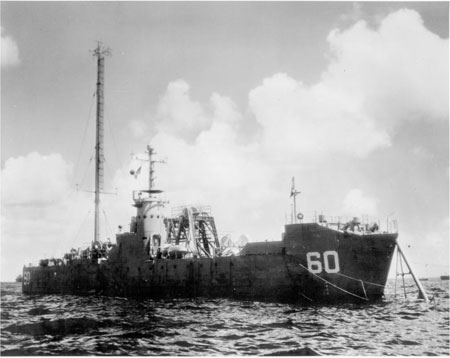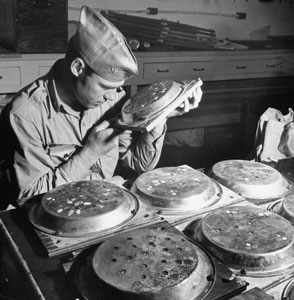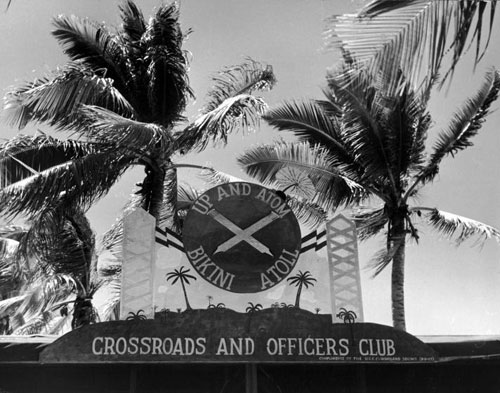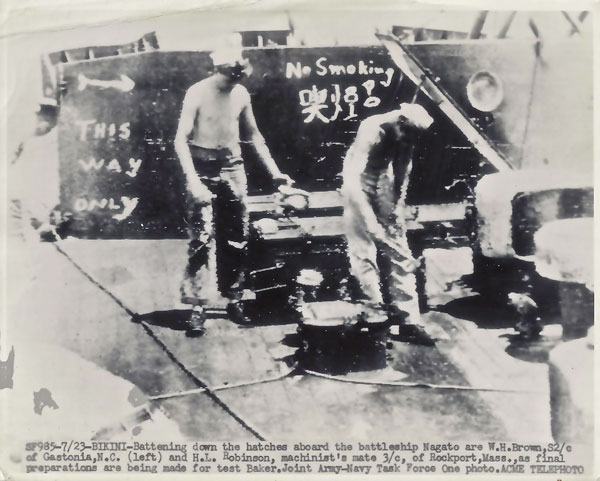
(LSM-60 configured for the BAKER test. Shown here is the antenna used to receive the radio signal that would trigger the bomb. The mid-ship hoist used to lower the bomb to the caisson is shown just forward of the bridge. This was the first underwater test of an atomic device, and the explosion produced so many unusual phenomena that a conference was held two months later to define new terms for use in descriptions and analysis. Photo USN).
Preparations continued in the lagoon throughout the first weeks of July, 1946, for the second Atomic test of the three-blast series of demonstrations. This one was imaginatively termed “BAKER.” People were constantly coming and going from Nagato’s deck as we pumped her out and dogged down hatches. Technicians were placing curious pie-plates with holes drilled in them to evaluate the effect of the atomic rays passing on shielded and unshielded surfaces.

Surveys of structural and watertight integrity, installation of test equipment, stripping of armament and other items not required as test equipment were conducted. The target ships were loaded as closely as possible to the battle or operating displacement of the ships. Varying percentages of the wartime allowance of ammunition and of the normal capacity of fuel oil and gasoline were carried in the ships’ magazines and bunker tanks. In some cases, emergency repairs were made to correct damage caused by the ABLE tests.
There wasn’t much talk about the SNAFU that had caused the ABLE Day bomb to land so far from the intended target. Joint Task Force ONE was configuring the test ship for the shallow-water detonation. ABLE had been an air burst, and the scientists told us this was high enough above the surface to prevent materials being drawn up into the fireball. My friend from Los Alamos told me the height-of-burst for the first nuclear explosion at Trinity Flats had been on a tower about a hundred feet high. It produced a crater 6 feet deep and 500 feet wide, and there was some local radioactive material in the air- what he termed a new thing called “Fallout.” We knew nothing about anything like that at the time- Trinity had been a secret test, after all, and the two bombs used on Japan had been detonated at altitude.
ABLE had been set to go off at 520 feet, an altitude considered to be sufficient that the radioactive products would rise to the stratosphere and become part of the global environment rather than contaminating the local area. The scientists knowingly told us that the airburst was considered to “self-cleansing,” which is why we were permitted to re-embark the battleship so quickly.
That was not going to be the case for the BAKER test. To get a better feel for the effects of the concussion and blast on surface ships and submarines, the Fat Man bomb was slung in a caisson at a depth of 90 feet below a medium sized landing vessel. LSM- 60 was anchored in the exact middle of the target formation, and thus was prepared to become the first ship ever to deploy an A-Bomb.
This device, by the way, also had a name, just as “GILDA” did. The BAKER bomb was named “Helen of Bikini.” I never got a decent explanation for why they chose that name, since Helen of Troy was the cause of the Trojan Wars. Perhaps like naming hurricanes after women, the fury of the devices was supposed to be akin to that sometimes displayed by the fairer sex.

There was swimming, and last visits to the Officers Club that had been established ashore- the “Up and Atom.”
As the test date approached, “Helen of Bikini,” was placed in a steel caisson manufactured by the scientists at Los Alamos from the conning tower of USS Salmon (SS-182) which had been scrapped in April 1946. Carl Hatch, U.S. Senator from New Mexico and an observer at the tests, chalked the words “Made in New Mexico” on its side before it was lowered down.
The test was set for the 25th of July- the 24th on the other side of the Dateline back stateside, and we followed the same drill as we did for the ABLE test. We ensured that Nagato was as ready as she was going to be, hatches dogged tight, pie pans set, instruments placed, and all made ready. We had no test animals onboard, but other ships did- pigs and rats this time. All the goats had been offered up to ABLE.

Then we were again evacuated to the support ships anchored this time nearly nineteen miles away from the point of detonation. We had a movie night and ice cream that melted rapidly. I slept well, though not in my own bunk on the Japanese battleship.
BAKER in the morning.
Copyright 2015 Vic Socotra
www.vicsocotra.com
Twitter: @jayare303
